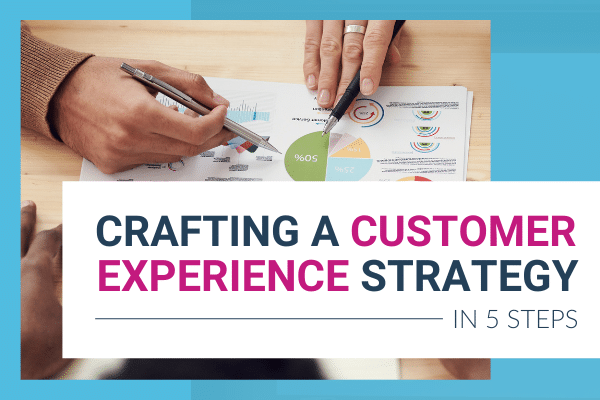Customer experience impacts your entire business from the ground up. While most businesses today know this is non-negotiable, it’s still not always easy to craft a customer experience strategy on your own. This is especially true if you’re starting from scratch.
With a reported 86% of customers willing to pay more for a better experience, this is one of the best ways to earn more. Better yet, focusing on customer experience sets you apart from the competition. It shows that you take the needs of your customers seriously, and you’re not afraid to act on feedback.
Customer experience (CX) is defined by the sum of interactions and experiences customers have with a business. These take place throughout the entire customer journey. They start before that individual even makes a purchase, and they continue as they become loyal superfans.
When you create a memorable, meaningful experience with customers, they’re excited to share this experience. Not only will they refer others, but they’ll continue to support your brand in the future. However, you’re not the only brand competing with customer experience. This is the newest (and most competitive) battleground for brands in 2022 and beyond. Luckily, this guide is here to share how to craft a customer experience strategy in 6 steps.
What are the benefits of having a customer experience strategy?
First, what are the benefits of having a customer experience strategy as a brand? Your business completely relies on your customers. Without them, you have nothing. This is why you need to know how to win business and retain the existing customers you have. All of this comes down to your customer experience strategy.
Still, it’s helpful to have concrete reasons why you need a customer experience strategy. We can identify a few key reasons that stand out above the rest, but this is far from a complete list:
- Brand loyalty: To begin, a positive experience promotes customer loyalty. When customers have a poor experience, they’re 4x more likely to stop supporting your brand.
- Sales strategies: Next, when you’re focused on your customer experience strategy, it’s easy to adjust your sales process. You can adapt to your customers’ needs, making the most of each interaction.
- Reputation: Your brand reputation matters more than ever in the digital age. When customers have a great experience, they want to share it. The opposite is also true, so your brand reputation is always on the line.
- Revenue: Did you know a customer experience strategy also boosts your revenue. It’s true, and 72% of customers will choose one brand over another based on experience alone.
- Trust: Lastly, customers are constantly bombarded by messages, ads, and brands. The world is saturated with loud imagery and adverts. The only way to build loyalty with customers is through trust in your customer experience.
How often should you adjust your customer experience strategy?
Next, how often do you need to adjust your customer experience strategy? Many brands make the mistake of thinking customer experience is one-and-done. While it’s important to spend a lot of time creating a strategy, this isn’t something you set and forget about. It constantly needs to evolve based on what’s working, customer feedback, and trends.
As customer experience continues to surpass price and product in the past years, you need to pay close attention to your strategy’s effectiveness. What’s currently bringing in business? What needs to be revamped or optimized? How often you adjust your strategy depends on your specific business and feedback.
While there is no clear answer, the best way to know when you need to change is when you notice fluctuations in your key metrics. For example, if you’re getting a lover NPS score (which tracks customer satisfaction), there’s a disconnect between your brand and your customers’ needs. The more attuned you are to your customers’ current feedback, the better equipped you are to stay light on your feet.
How do you develop a customer experience strategy?
With that in mind, how do you develop a customer experience strategy with your brand in mind? While this depends on your specific brand and needs, there is a 6-step process all businesses can follow. These are the same no matter where you’re at in your brand journey, from startup to big-name corporation.
Collect feedback from your existing customers.
To begin, you can’t create a strategy if you don’t take inventory of where you already are. This means collecting feedback from existing customers. It’s easy to assume you know your customers best, but there’s often a disconnect. You know what they say about assuming…
Just taking the time to ask customers for feedback makes a positive impact. Your customers want to feel heard and understood. Not only does asking for feedback reinforce positive experiences, but it’s a driver of long-term growth. You can ask for feedback in many different ways:
- Surveys
- In-app or on-page questionnaires
- Phone calls
- Emails
- Support interactions
- Social media
- Suggestion boards
Not only should you always thank them for feedback, but consider any real takeaways. You might discover product improvement areas, customer service concerns, and other things imparting the big-picture journey. When you identify ways to grow, you have a roadmap forwards.
The up-and-coming friendship building app Hey! VINA isn’t afraid to ask for user feedback right away. Their feedback email comes directly from the founder and CEO, making it a personal call to action. In exchange for feedback, they enter users into the running for some free swag. This is a win/win all around!
Research other customers in your industry.
Next, it’s important to research other customers in your industry. You don’t exist inside a bubble. You have to consider ways your competitors are reaching customers over you. While this doesn’t mean you have to completely copy-paste anyone else’s strategy, you should be mindful of ways they’re succeeding.
To begin, do competitor research. See why customers choose specific competitors over you. Look through their reviews to see how your brand compares. Odds are, there are things your competitors are doing that you can easily steal. It’s important to do your own thing, but you have to be aware of how the industry is adapting as a whole. You don’t want to get left behind.
The most obvious example of this is Amazon. While it’s true Amazon created a strain for many small and big-name retailers, it also pushed the industry as a whole further. Things like the “buy now” one-click buying truly changed the world of ecommerce. Today, you can see countless brands of all shapes and sizes replicating these things to win customer loyalty.
Even if you can’t compete with big-name competitors when it comes to price, fast shipping, or inventory, you can find similar ways to stand out. For example, Nordstrom continues to shine over other trusted retailers like Amazon because of its commitment to customer service. Even though Nordstrom is notoriously more expensive, they make this worth it with their amazing service and values.
Evaluate your current company mission, vision, and core values.
Third, when creating a customer experience strategy, you need to evaluate your current company mission and values. People value transparency more than ever before. They want to support brands that are doing good. It’s not enough to talk the talk. You have to actually walk the walk.
Consider your current company mission, vision, and values. Do your current strategies reinforce these values? For example, if you want to bring customers the best shoes on the planet, you’re not actually living up to that mission if you’re not also taking into account customer feedback. It’s not enough to think you’re doing the best. You need to take the time to back up these claims.
Believe it or not, 71% of consumers today prefer to buy from companies that are aligned with their values. Whether that means supply chain transparency, eco-conscious practices, or attention to detail, your values matter. This is especially true for younger generations. With more than 50% of an experience based on emotion, you need to optimize for the emotional, real-world connection.
To see this in action, look at Rothy’s shoes. This eco-friendly startup claims to create the best recycled, washable shoe for everyday wear. Created using single-use plastic water bottles, they create sustainable styles that hold up. However, they don’t just take their own word for it. Their reviews show just how much customers love these shoes—as well as the good they do for the planet.
Map out your customer journey and identify pain points.
Fourth, your customer journey needs a clear map. This collection of pain points helps overcome customers’ natural objections throughout the process. It’s normal for customers to wonder whether you’re the right fit for them. It’s your job to clear up these concerns throughout the customer journey.
Now that you’ve defined your vision and core principles, you’re ready to build a customer journey with this in mind. This is a visual representation of the process a customer or prospect travels between learning about your company and becoming a customer. It should focus on important pain points (or challenges) along the way. The customer journey includes these stages:
- Awareness: This is when your customer first learns about your brand. It includes all messaging on your website, social media, and so on.
- Consideration: Next, your customer takes a step closer, likely signing up for your email list or talking to a sales rep.
- Decision: Lastly, your customer makes a final decision, hopefully landing in a sale or referral.
The big-name coffee company Starbucks does a great job of mapping out its customer journey. By encouraging customers to sign up for the Starbucks Rewards app (in exchange for a free drink), they continue to guide customers through their journey from casual cup-of-joe drinkers to avid coffee fans.
Set S.M.A.R.T. goals for your team as you implement new strategies.
Fifth, set clear goals for your team. As you implement new strategies around customer experience, you need a way to measure real progress. This is where SMART goals come in. A SMART goal is Specific, Measurable, Achievable, Relevant, and Time-Bound. When thinking about your brand, your goals might look like:
- Speed up your response time
- Boost your email subscriber count
- Create a customer referral program
- Enable customer self-service by building a guide
- Share 3 feedback surveys per quarter
- Strengthen customer onboarding
No matter your goals, make sure they’re reasonable and measurable. The better you get at keeping track of your own CX metrics, the more likely you’ll be attuned to your growth and progress. If you don’t know where you’re going, it’s impossible to get there.
The grocery chain Trader Joe’s is a fantastic example of a brand that understands and measures SMART goals. Though most grocery chains experienced a steep drop in shoppers during the COVID pandemic, Trader Joe’s saw this as an opportunity to step up its goals. By positioning itself as the go-to, safe place for loyal customers, they’ve managed to return to pre-pandemic levels in record time.
Repeat this process every quarter.
Finally, this is a process you need to repeat every quarter. Crafting a customer experience strategy means taking a quarterly approach to progress. What worked in the past isn’t guaranteed to work in the future. If there’s one thing we can learn from the pandemic of 2020 (and beyond), it’s that there’s no such thing as too comfortable.
Quarterly planning doesn’t have to be complicated. While annual planning is important, sometimes things change quickly. Having a quarterly mindset means you’re ready to pivot as needed, reaching your customers when it matters the most. What should you include in your quarterly plan?
- Your SMART goals
- A recap of your previous quarter
- New customer feedback
- Upcoming initiatives
Taking the time to examine what worked last quarter as well as what didn’t make all the difference. The best brands in this era are the ones who aren’t afraid of change. The tried-and-true is no longer the go-to.
Just look at the music streaming service Spotify. Though they originally focused on artists and curated playlists, they realized they were neglecting original content. To compete with streaming providers like Netflix and Apple TV, Spotify quickly upped their original content like Spotify Originals. This made the go-to content creator, not just a music curator.
Conclusion
Ultimately, having a detailed, evolving CX strategy is the best way to retain your customers while also building upon current traffic. If you’re constantly chasing new customers, odds are your CX strategy is to blame. With a small fraction of companies taking real action from feedback, you need to go the extra mile to make sure they feel heard.
Have you truly invested in your superfans? Make this the year of growth, change, and putting your customers first. Your customer experience strategy is something you can build from scratch, but you have to start today.





